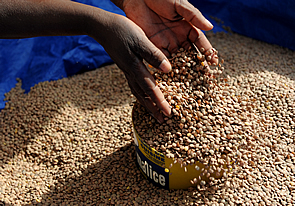Issues
- Food Assistance
- Governance
- Health
- Earthquake
- Cholera
- HIV AIDS
- IHRC
- Rubble Removal
- Shelter
- Gender
- Land Tenure
- Oversight of US Funds
- Land Tenure
- Disabilities
- Institutional Strengthening
- Haitian Diaspora
Related documents
- Funding (PDF, 412KB)
- Shelter (PDF, 368KB)
- Rubble (PDF, 328KB)
- Energy (PDF, 289KB)
- Caracol Industrial park (PDF, 337KB)
- Economic Security (PDF, 177KB)
- Food Security (PDF, 172KB)
- Health (PDF, 302KB)
- Cholera (PDF, 328KB)
- Education (PDF, 367KB)
- Governance and Rule of Law
(PDF, 193KB) - Gender (PDF, 205KB)
Food Assistance
Even before the January 12, 2010, earthquake that devastated Haiti, its people faced malnutrition and food insecurity and were extremely vulnerable to any natural disaster that disrupted their ability to grow crops. Haiti was the poorest country in the Western Hemisphere and ranked 148 out of 179 on the UN Human Development Index, eighty percent of the population was under the official poverty line, and one Haitian child out of every four children was chronically undernourished.
Focus: Reducing Vulnerability

Photo Copyright: Janice Laurente/USAID
Through the U.S. Agency for International Development (USAID), the U.S. Government is working to reduce Haiti’s vulnerability to food crises and improve Haitians’ long-term health. To date, USAID has provided $140.6 million in emergency food assistance through the World Food Program and private voluntary organizations. USAID also provided partners with $47.5 million for food vouchers and short-term employment programs that will give households the ability to purchase food for their families and support the recovery of markets. Additionally, USAID is providing $35.5 million annually for longer-term food assistance that enables very food insecure households to increase their agricultural production and improve their health and nutrition.
Results: Improving Haiti’s Food Assistance
Short-term interventions in the immediate aftermath of the earthquake helped keep Haitians healthy while USAID designed programs to help improve Haiti’s long-term Food Assistance. Emergency food relief reached 4 million people in the first three months after the earthquake, the largest-ever urban food distribution.
Long-term programs have been successful because of the interventions and farming techniques introduced through our programs since the spring of 2010:
- As the situation stabilized after the earthquake, USAID’s assistance evolved. Food distributions were phased down to target the most vulnerable while vouchers and temporary employment programs helped affected households meet their food needs while supporting the recovery of local markets.
- Targeted food aid is currently being distributed to approximately 300,000 through development programs designed to address chronic food insecurity. This includes a school feeding program that provides meals to 44,000 children daily.
- While 60 percent of Haitians work in agriculture, more than 50 percent of the food consumed in Haiti is imported. Through the USAID WINNER program, yields in three different areas of the country increased production by 75 percent overall, including a 139 percent increase for sorghum and a 118 percent increase for corn.
- Results from a rice cultivation trial produced yields that were, on average, 150-190 percent higher, reducing seed requirements by 80%, generating 30% savings in irrigation water, shortening production time by 10 days, and doubling profit per unit area compared to the same varieties grown in a traditional manner.
